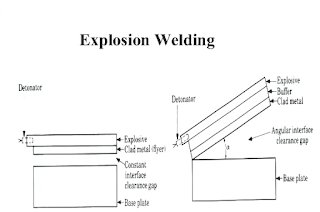 |
| Explosive welding |
Explosive welding is a solid-state welding process where the joint is affected by the high-velocity movement produced by a controlled detonation.
Explosive Welding Construction:
Explosive welding is used primarily for bonding sheets
of corrosion-resistant metal to heavier plates of base metal (a cladding
operation), particularly
when large areas are involved. The principles of explosive
welding have been schematically illustrated in Fig. The bottom sheet
or plate is positioned on a rigid base or anvil and the top sheet is
inclined to it with a small open-angle between
the surfaces to be joined. An explosive material, usually
in the form of a sheet, is placed on top of the two layers of
metals and detonated progressively, beginning from the mating
surfaces. Compressive stress waves, of the order of thousands of Mega
Pascals, sweep across the surface of the plates. Surface films are liquefied
or scared of the metals and are jetted out of the
interface. The clean metal surfaces are then thrust together
under high contact pressure. The result is a low-temperature weld with an
interface configuration consisting of a series of interlocking ripples.
The bond strength is quite high and explosive
clad plates can be subjected to a wide variety of subsequent processing,
including further reduction in thickness by rolling. In this
solid-state welding process, numerous combinations of dissimilar metals can be joined.
Explosive Welding Working :
The flyer plate is to be joined with the parent plate. There is a
buffer above the flyer plate which may be of rubber. Cardboard
or similar material to protect the surface of the flyer plate from
damage. Above the buffer is a layer of explosive which is detonated from the lower
edge.
As the explosives ignited, the detonation wave front progresses across
the surface of the flyer plate in a straightforward and uncomplicated manner. The
explosive impulse provides both extremely high normal pressure and a slight,
relatively sliding pressure between the flyer plate and the parent
plate. At the point of impact, S as shown in fig, high instantaneous pressure is
generated which is large compared with the shear
strength of the materials.
explosive welding advantages and disadvantages
Advantages of explosive welding
1) The simplicity of the process.
2) Extremely largesurface can be bonded.
3) Welds can be produced on heat-treated metals without
affecting their microstructure.
4) Thin foils can be bonded to a heavier plate.
5) Explosive bonds have a solid-state joint that is free
from the heat-affected zone.
6) Luck of porosity, phase change, and structural
changes impart better mechanical properties to the joint.
Explosive Welding Limitations
In industrial areas, the use of explosives will be
severely restricted by the noise and ground vibrations caused by the explosion.
1) The regulations relating to the storage of explosives and the problem
of preventing them from falling into unauthorized hands may well prove to
be the main obstacle to the use of explosive welding.
2) Metal thickness greater than 62 mm of each alloy
cannot be joined easily and required high explosive loads.
3) Materials such as beryllium, tungsten boron, glass,
and ceramics are not normally processed by explosive welding.
Explosive Welding Applications
1) Many dissimilar metals
combinations have been joined successfully with the help of explosive
welding.
2) Strong metallurgical bonds can be
produced between metal combinations that can not be welded by other processes.
3) Pipes and tubes up to the 1.5-meter length
have been clad with this process.
4) In critical space and nuclear applications, explosive
welding permits the fabrication of structures that cannot be made by other means.
5) Major areas of use of explosively clad products are heat exchange tube
sheets and pressure vessels.
6) Explosive cladding is finding use in the die-casting industry for nozzles,
die-cast biscuits, and other components.
7) Explosive welding has been used for the plugging
of nuclear heat exchanges.
8) Metal/metal wire composite materials have been fabricated using explosives
welding.







0 Comments
Leave a Reply...